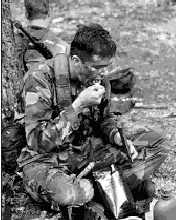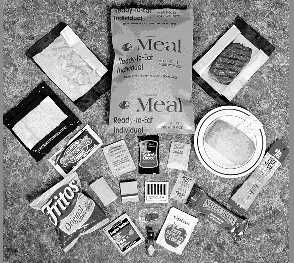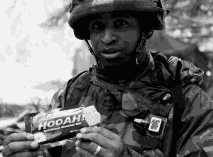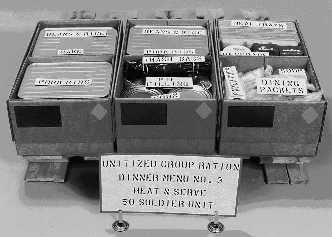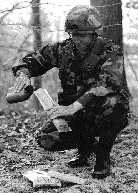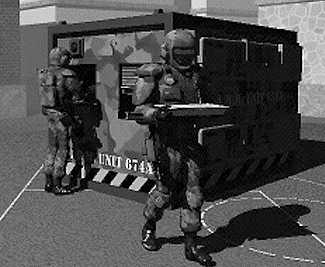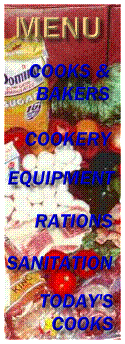
Combat Ration
Logistics
From Here to
Eternity
by Joseph A. Zanchi and Alan J. LaBrode
As the 21st century approaches, state-of-the-art technologies are providing today's warriors with the highest quality rations in the world. Modern battlefield requirements demand ration support systems that adequately provide for the needs of the individual warfighter in extremely intense and highly mobile combat situations. The revised national military strategy of power projection of primarily continental United States (CONUS) based forces and planning for Joint Vision 2010 and the Army After Next require revolutionary approaches and "out of the box" thinking to support this dynamic battlefield of the future. The preeminent land power forces capable of dominance across the full spectrum of conflict require an individual mounted and dismounted warfighter who can be sustained in any field environment. Widely dispersed, quick-moving, deployed forces will require total battlefield asset visibility and velocity management of all rations.
The Army Soldier Systems Command's (SSCOM's) Natick Research, Development, and Engineering Center (NRDEC) (renamed the Army Soldier Systems Center's Soldier Center of Excellence on 1 October 1998) is responsible for the design, development, and testing of military rations for the Army, Navy, Air Force, and Marine Corps. Under the auspices of the Department of Defense (DOD) Combat Feeding Program, research and development efforts since Operation Desert Storm have led to significant progress in improving the quality, variety, and acceptability of rations while reducing their weight and volume. Volume requirements for shipping special-purpose rations have been reduced by up to 38 percent. Ration storage life also has been extended, nutritional quality and content have been increased, and the durability of packaged rations has been improved. Additionally, stocking and ordering rations have been made significantly easier.
Innovative
Integrators
The standard military ration for the individual
warfighter is the meal, ready to eat (MRE), which
replaced the meal, combat, individual (C ration), in the
early 1980's. The MRE must maintain high quality when
stored for 3 years at 80 degrees and 6 months at 100
degrees Fahrenheit, must be highly palatable, and must
meet the nutritional requirements of the Office of the
Surgeon General (OTSG). Ration development constraints
include wholesomeness, producibility, cost, self-heating
capability, modularity, weight and cube, and performance
enhancement. In addition, MRE packaging must meet
stringent durability requirements, to include the ability
to withstand airdrop, rough handling, and temperature
extremes.
|
Enjoying an MRE in the field. |
Since its introduction, the MRE has been improved continuously. However, as a result of feedback from Operations Desert Shield and Desert Storm, major customer-driven improvements have expanded variety and improved palatability, consumption, and nutritional content to enhance performance on the battlefield. These rapidly fielded, customer-focused improvements have been made possible through the efforts of the Combat Ration Integrated Product Team (CRIPT), whose members include the customer, combat developer, materiel developer, procurement agency, and vendors. Since 1993, 70 new items have been approved for inclusion in MRE's, while 14 of the less acceptable items have been replaced. The number of menus has increased, incrementally, from 12 to 24, and 4 vegetarian meals now are included (2 in each case). A new easy-open meal bag with commercial-style colors and graphics has been added, and nutritional labeling has been implemented.
|
MRE improvements. |
A continuous product improvement program will enhance all of the fielded individual rations further by evaluating new items and preparing and transitioning performance-based requirements to the Defense Logistics Agency's (DLA's) Defense Supply Center Philadelphia (DSCP) for procurement. Current and future initiatives provide technology insertions to improve the MRE continuously to provide sustained energy, mental alertness, and eat-on-the-move capability for the warfighter, while reducing weight and volume, improving logistics, and enhancing performance.
Use of time and temperature indicator (TTI) labels on MRE ration cases has proven to be a great success in quickly and effectively monitoring the quality of pre-positioned MRE's. Because military rations must be pre-positioned, stored, and used under all environmental conditions worldwide, the TTI indicators are an important tool in ensuring that only the highest quality food is provided to our warfighters. The TTI labels attached to every MRE shipping case during assembly provide food inspection teams a new capability that virtually ensures "least fresh, first out" stock rotation. Since introduction of the labels, ration waste, spoilage, and inspection time have been reduced drastically .
The "bull's eye" TTI label has an outer reference ring and an inner circle that darkens with time. It darkens more quickly as the temperature increases. The quality of food products is highly dependent on the time and temperature of storage; therefore, the darkening of the inner circle is directly related to the quality of the food. In February 1998, the 106th Medical Detachment (Veterinary Services), with support from Eighth Army and the Pusan Storage Facility, retrofitted approximately 125,000 cases of MRE's stored in Korea with TTI's that were preessed to match the remaining shelf life of the MRE's. The remaining shelf life was determined based on the quality of the ration components observed during on-site inspections conducted by NRDEC personnel. This ration inspection helped to ensure that only high-quality rations are provided to our forces. As a result, the MRE's are more acceptable to the troops, more likely to be consumed, and consequently, they maximize the nutrient status of the soldiers. Future enhancements to the TTI label include a bar-code system that will provide readily accessible and retrievable baseline product data for inventory management and inspection, with encoded information adjustable to user requirements.
|
Nutritious HooAH! bar. |
Unitized
Group Rations
The unitized group ration (UGR) is
designed to simplify and streamline the process of
providing the highest quality group meals to troops in
the field by integrating heat-and-serve (H&S),
shelf-stable, and perishable rations with quickly
prepared, user-friendly, brand-name products. The UGR is
used to sustain groups of military personnel during
operations that allow organized food service facilities
to be set up. With the introduction of the UGR, the
number of line items to be ordered was reduced from as
many as 34 to no more than 3. The pre-mixed selection of
UGR menus ensures variety and maximizes consumption by
avoiding menu repetition and boredom. The UGR has 5
breakfast and 10 lunch or dinner menus. Currently, the
UGR_H&S is available for procurement. Each UGRH&S
module provides 50 complete meals, which are packed in 3
boxes, including disposable trays, cups, flatware, and
trash bags. Each pallet contains 8 modules, or 400 meals.
The UGR H&S is assembled at Government depots and has
a shelf life of 18 months at 80 degrees Fahrenheit.
|
Unitized group ration. |
The UGRA currently is being field-tested. UGRA is a "build-to-order" ration that can be delivered directly by the vendor when given a 30-day maximum lead time. It has a 6-month shelf life. This all-commercial option will provide all of the components needed to prepare 50 perishable meals (A-rations) in the field. A medical supplement to the UGR streamlines the ordering process for medically unique components that augment the UGR for hospital field feeding. Each module is designed to support a 50-patient combat support hospital for 5 days.
The Fielded Group Ration Improvement Program continues to assess new and improved group ration components, including nondevelopmental and in-house-developed entrees, starches, vegetables, snacks, and desserts to determine customer acceptance and preference. Fiscal year (FY) 1998 field assessments of the UGR included monitoring the procurement, distribution, and acceptance of an all-commercial A ration and a field evaluation of new and improved H&S ration components. The UGRA award by DSCP to a prime vendor represents the first attempt to move unitized commercial A rations to the field, where it is being praised by cooks and soldiers. The UGRA data collection plan was completed and implemented in the second quarter of FY 1998. Two test sites—Fort Hood, Texas, and Fort Stewart, Georgia—currently are procuring the UGRA. All aspects of this concept are being monitored at both sites, including acceptance by troops, cooks, and food-service personnel and the logistics involved in its use. Fifteen menus were reviewed and revised to reflect NRDEC data collection and industry analysis of surge capabilities. Packaging improvements will continue to be incorporated to reflect state-of-the-art technologies.
Feedback has indicated that the process of ordering, issuing, and preparing meals has been simplified greatly while offering a menu that is both nutritious and highly acceptable and maximizing the "right size-right component" concept for the customer. It offers recognizable brand-name commercial products; reduces labor with easy-to-prepare, user-friendly components; reduces lead-times in ordering; and reduces Government inventories.
Field studies also were conducted in several areas to assess different levels of interest in improving food stability and determining the shelf life of rations in environmental extremes. An investigation conducted under the Food Stabilization Program revealed that use of solar shields yielded a 5-degree Fahrenheit decrease in internal temperature of container storage vans, which increased the shelf life of rations, validated TTI quality correlation, and determined objective color evaluations for heat-sensitive ration components as quality indicators. This information was forwarded to the Army Veterinary Command and DSCP for inclusion in DSCP Handbook 4155.2, Inspection of Composite Operational Rations, and distribution to inspectors. As a result of additional test data, storage temperatures of MRE's have been adjusted, which will result in a saving of $3 to $4 million per year in storage costs. Further, heat-sensitive ration components were reformulated and improved to increase heat stability.
Long-Range Patrol
Packet
To meet the needs of special operations forces, a
lightweight, low-volume food packet was developed that
was similar to the long-range patrol (LRP) food packet
used successfully during the Vietnam War. However,
because of advances in food and packaging technologies,
the new food packet provides 40 percent more calories
than the earlier version. The long-range patrol-improved
(LRP-I) food packet has gained high troop acceptance, is
inexpensive, can be airdropped, has a potential 10-year
shelf life at 70 to 80 degrees Fahrenheit, and weighs
less than 1 pound per individual meal. Packaging and
design changes incorporating brick packaging for instant
dehydrated entrees have significantly reduced the weight,
volume, and producibility of the LRP-I and increased menu
and component variety.
As a result of the improved LRP design, there is now a peel-and-seal menu bag and a new, more logistically supportable case configuration. The new design represents a 21-percent weight reduction, a 38-percent volume reduction, a 20-percent increase in pallet load capacity, and a reduction of 19 MILVAN's per procurement in logistics shipping requirements.
The OTSG and the Joint Service Operational Ration Forum recently have approved combining the meal, cold weather (MCW), and LRP food packets. Twelve new menus were designed and have been approved by the OTSG for their nutritional content. The MCW and LRP will have the same components and menus; however, each ration will retain its current nomenclature and packaging color as requested by the military services. The MCW will have white interior and exterior packaging and the LRP will be brown and tan. Performance-based contract requirements for the newly combined ration are being coordinated.
Significant initiatives focused on eliminating foil-based packaging materials in MRE components and on developing a high-barrier menu bag secondary packaging system also are being pursued. Expected benefits include a net decrease in the cost of ration packaging, increased use of commercial nonfoil packaging materials, improved reliability, reduced battlefield waste, decreased MRE weight and cube, increased acceptance through brand-name packaging, and potential for expanded military use of low-barrier, biodegradable packaging materials
NRDEC is working aggressively to replace the flameless ration heater (FRH) with a new nonflammable ration heater (NRH) that is equally safe, affordable, and effective while offering unrestricted operation, transportation, and storage. The end products of the heater are nonhazardous and are environmentally safe for disposal.
Considerable effort also is underway to redesign ration menus to reduce the cost and logistics burden of purchasing, storing, and shipping food that will not be consumed, optimize warfighter satisfaction, and maximize acceptance, consumption, and nutrition. This effort is projected to reduce ration weight, size, and cost by 10 percent.
Proof Is in
the Pudding
Acquisition reform and changes in MRE
storage temperature, time-temperature indicators, and
case and shipping container design, along with changes in
the 18-soldier UGR, such as packaging reconfiguration,
addition of new H&S entrees, and vegetable can
substitution, are projected to result in a total savings
of approximately $19 million per year.
Integration of the MCW and the LRP food packets, by using standardized commercial entrees and components and reconfiguring the case insert and sleeve, will provide total savings estimated at $400,000 per year. Additional savings in excess of $19 million per year also may be realized through a number of promising individual efforts under the Savings Through Value Enhancement and Operating and Support Cost Reduction programs.
As further evidence of the outstanding efforts to apply acquisition reform within the military ration program, SSCOM personnel were notified in June 1998 that the Military Rations Process Improvement Team had been selected to receive Vice President Al Gore's Hammer Award. They were chosen for this honor for their extraordinary efforts in developing innovative, performance-based contract requirements to replace hundreds of detailed military specifications. The team took the lead, with help from DSCP and the operational ration industry, to ensure that customers receive the best possible rations at the best possible price while complying with DOD directives on acquisition reform.
Fueling the
Warfighter—2010 and Beyond
The DOD Combat Feeding Program is
inexorably linked with Joint Vision 2010 and Army After
Next, as well as Sea Dragon 21st Century and Air Force
2025. To meet the needs of the 21st century warfighter
and support the operational concepts of Joint Vision 2010
and Army After Next, science and technology resources in
the DOD food program have been allocated to explore
breakthrough technologies, including innovative food
processing, smart packaging, cogeneration, and diesel
reforming technologies. It is envisioned that these
revolutionary technologies will enhance warfighter
performance by 30 percent, reduce ration weight by 50
percent, reduce food-service-related fuel consumption by
50 percent, and reduce operations and support costs by 40
percent.
Revolutionary technologies are being pursued aggressively to provide novel, fully integrated combat rations and food-service field equipment. NRDEC's combat support systems food and food-service equipment business area and critical, focused technology thrust areas provide direct support to some highly leveraged technology initiatives. These initiatives promise to provide soldiers with improved "fuel" that is tailored to increase combat effectiveness and reduce battlefield stress.
Leap-ahead technologies in combat rations and field food-service equipment will enable warfighters to achieve full-spectrum dominance by using performance-enhancing ration components, diesel fuel reforming technologies, advanced waterless preparation equipment, smart processing and preparation, automation, and alternative-energy-driven systems. These affordable systems will reduce both logistics support requirements and the associated combat footprint.
A number of technology initiatives support key strategic military objectives—
Dominant maneuver will be achieved with enhanced mobility and increased agility through lightweight, low-volume, globally compatible rations and equipment that will enable the warfighter to go farther and faster, and to be more lethal. Innovative formulation and processing technologies, such as pulsed electric field, radio frequency, pulsed light, high-pressure, ohmic, or microwave thermal processing, and application of biotechnology, will be explored and developed. Synergistic approaches to both processing and packaging will provide foods that are nutritious, fresh, compact, lightweight, and consumable across the continuum of combat operations. Novel, nonthermal processing methods, combination preservation strategies, multifunctional polymeric materials, and active packaging systems will provide higher quality field rations at reduced cost and reduced weight and volume will foster a stable industrial base with a large surge capability. Initial laboratory studies indicated that warfighters will extend their physical endurance by approximately 17 percent by consuming an energy rich-beverage. Rapidly deployable, trailer-mounted kitchens will keep pace with warfighters enabling fresh, cook-prepared meals to be provided farther forward.
Focused logistics will be supported through tailorable ration and food-service equipment modules that are compact and highly proficient and require minimal theater support. This will shrink the logistics umbilical cord significantly worldwide. State-of-the-art primary packaging improvements to the LRP food packet already have resulted in a 16-percent reduction in the number of MILVAN's needed to support a 10-day feeding cycle. Technologies for safely moving, storing, preparing, and dispensing shelf-stable, fresh, and frozen foods in the field during combat operations will enhance the nutritional status of the individual warfighter, improve morale, and counter the threat of energy depletion while supplying the warfighter with high-quality, home-cooked-style meals. Equipment and energy technologies include heat-driven refrigeration, modified atmosphere systems, thermal energy storage, advanced insulation, waterless food sanitation, and biosensors for assuring food safety. Breakthrough technologies in cogeneration and diesel reforming will reduce fuel consumption for food preparation by 50 percent, with a commensurate reduction of O&S costs by dual use of equipment and integration of commercial off-the-shelf foodservice equipment.
Enhanced precision engagement will be realized by optimizing the warfighter's cognitive abilities. Cutting-edge food and nutrition technologies will be developed to increase mental alertness and enhance thinking. These evolving technologies are expected to reduce combat stress and allow 24-hour sustained operations. New laboratory analytical techniques, modeling, and simulation will be used to establish guidelines on the impact of specific nutrients on soldier performance and will transition into ration feeding programs that enhance warfighter performance.
Full dimensional protection will be supported through dynamic ration module selection systems. The systems will tailor combat rations and field food-service technologies to support the warfighter and optimize performance in all environmental extremes. Multifunctional packaging systems and high-barrier polymeric materials that protect subsistence from battlefield threats, to include chemical and biological agents, will enhance the capability to feed the warfighter in all combat environments.
|
Flameless ration heater. |
Cogeneration and diesel reforming technologies will enable the use of thermophotovoltaics instead of generators, thereby reducing thermal and noise signatures, increasing reliability, and reducing operating and support costs. [Thermophotovoltaics involves the conversion of radiant energy into electrical energy by using photocells.] Advanced waste management systems are projected to reduce field waste by 50 percent with a 20-percent reduction in processing costs.
Innovative, multifunctional, and "smart" packages that incorporate antimicrobial compounds and materials are being developed to absorb or control by-products, odors, aromas, or headspace gases that are emitted by ration components. These packages may be used to contain food products that are most negatively affected by long-term storage. This work will improve ration acceptability, safety, and consumption, thus improving the nutritional status of the warfighter as well as reducing perishable food waste. It also will increase the variety of fresh-like rations by inhibiting or retarding chemical changes or spoilage of minimally processed foods.
The science and technology thrust areas for combat rations and field food-service systems focus on meeting the performance requirements of Joint Vision 2010 and beyond. These technologies are positive force multipliers in both limited and sustained operations. They will enhance the warfighter's capability to process myriad information produced on the digitized battlefield and greatly improve his combat effectiveness, quality of life, and survivability.
Together with our customers, we have completed our first brainstorming session to define conceptual capabilities and the revolutionary technology needed to provide these capabilities in support of the Army After Next. These technological innovations not only will achieve greater performance capability, lethality, sustainability, and survivability, but they also will support transformation strategies that will result in revolutionary military logistics.
Contemplate a self-reliant, future warfighter and soldier system that, together, are able to make a swift and decisive first strike that is supported by a self-tailoring ration system. Such rations will have components genetically structured to release appropriate energy boosters, neurotransmitter precursors, illness suppressors, wound-healing compounds, and performance-enhancing formulations. These components will be controlled either by the warfighter using a nutritional status monitor or remotely by lasers. Pre-selected ingredients will be released at the appropriate time via a skin patch to ensure the soldier's optimum response to the combat, environmental, or tactical situation. A more revolutionary application of this technology may involve undergarments impregnated with selected nutrients. The right nutrients would be absorbed through the skin according to information from nutritional sensors embedded in the clothing system. Developing such self-tailoring rations and in-suit supplements will require a combination of innovations in food formulation, structure, processing, and methods of absorption. These breakthroughs could conceivably provide a 25-percent decrease in logistics requirements, a 100-percent utilization of rations, and a 50-percent improvement in warfighter health and performance.
|
Future automated feeding system. |
The DOD Combat Feeding Program is indeed an unequivocal force multiplier supporting our greatest asset, the warfighter. Our partnerships with industry and academia continue to uncover new solutions and capabilities that leverage revolutionary technologies. These technologies provide fully integrated, novel systems supporting U.S. military objectives. It is our collective visionary perspective that will enable the warrior to dominate the 21st century battlefield. It has been said that the best way to predict the future is to invent it. It is a journey that we already have embarked on and a challenge we clearly have embraced.
Reprinted from the January/February 1999 issue of Army Logistician.
Joseph A. Zanchi is a logistics management specialist in the DOD Research, Development, Test, and Evaluation Combat Feeding Program, U.S. Army Soldier Center of Excellence, Natick, Massachusetts.
Alan J. LaBrode is a physical scientist in the DOD Research, Development, Test, and Evaluation Combat Feeding Program, U.S. Army Soldier Center of Excellence, Natick, Massachusetts.
| Bulletin Board | Keyword Search |
| Bookstore | Links |
| About Us | Recent Additions |


